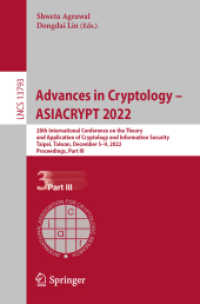- ホーム
- > 洋書
- > 英文書
- > Science / Mathematics
Full Description
The need for advanced thermal management materials in electronic packaging has been widely recognized as thermal challenges become barriers to the electronic industry's ability to provide continued improvements in device and system performance. With increased performance requirements for smaller, more capable, and more efficient electronic power devices, systems ranging from active electronically scanned radar arrays to web servers all require components that can dissipate heat efficiently. This requires that the materials have high capability of dissipating heat and maintaining compatibility with the die and electronic packaging. In response to critical needs, there have been revolutionary advances in thermal management materials and technologies for active and passive cooling that promise integrable and cost-effective thermal management solutions. This book meets the need for a comprehensive approach to advanced thermal management in electronic packaging, with coverage of the fundamentals of heat transfer, component design guidelines, materials selection and assessment, air, liquid, and thermoelectric cooling, characterization techniques and methodology, processing and manufacturing technology, balance between cost and performance, and application niches. The final chapter presents a roadmap and future perspective on developments in advanced thermal management materials for electronic packaging.
Contents
CH. 1. Thermal managing fundamentals and design guide in electronic packaging.- 1.1 Introduction.- 1.2 Thermal management challenges and common.- concerns.- 1.3 Fundamentals of heat transfer.- 1.4 Thermal management solutions.- 1.5 Design for advanced thermal management of electronic packaging.- 1.6 Materials selection for advanced thermal management.- 1.7 Environmental compliance of thermal managing materials.- CH. 2. Characterization methodology of thermal managing materials.- 2.1 Thermal properties and measurement techniques.- 2.2 Electrical properties and measurement techniques.- 2.3 Thermomechanical characterization.- 2.4 Analytical techniques for materials characterization.- 2.5 Surface finish and contact interface compatibility.- 2.6 Reliability analysis and environmental performance evaluation.- CH. 3. Electronic packaging materials and their thermal managements.- 3.1 Materials selection for electronic packaging.- 3.2 Ceramics and semiconductors.- 3.3 Electronic glasses.- 3.4 Polymers.- 3.5 Monolithic metals.- 3.6 Metallic composites.- 3.7 Multimaterial laminates.- 3.8 Printed Circuit Board (PCB) Materials.- 3.9 Thermal interface materials.- 3.10 Advanced thermally conductive materials.- CH. 4. THERMALLY conductive carbonaceous materials and carbon matrix composites.- 4.1 Introduction.- 4.2 Natural and industrial graphite.- 4.3 Pyrolytic graphite.- 4.4 Graphite/Carbon Foams.- 4.5 Thermally conductive carbon fibers.- 4.6 Diamond.- 4.7 Carbon Nanotubes.- 4.8 Carbon/carbon composites.- CH. 5. Thermally conductive polymer matrix composites.- 5.1 Introduction.- 5.2 Polymer matrix types.- 5.3 Reinforcements selection and its effect on thermal conductivity.- 5.4 General fabrication and manufacturing processes.- 5.5 Types and applications for thermal management.- CH. 6. High thermal conductivity metal matrix composites.- 6.1 Introduction.- 6.2 Processing of metal matrix composites.- 6.3 Aluminum matrix composites.- 6.4 Copper matrix composites.- 6.5 Other metal matrix composites.- CH. 7. Thermally conductive ceramic matrix composites.- 7.1 Introduction.- 7.2 Diamond-SiC composites.- 7.3 Carbon-SiC Composites.- 7.4 Reaction-Bonded SiC.- 7.5 Aluminum-toughened SiC.- 7.6 CNT/Ceramic- carbon nanotube composites.- CH. 8. Thermal interface materials in electronic packaging.- 8.1 Thermal contact conductance and requirement for thermal interface materials.- 8.2 Metallic thermal interface materials.- 8.3 Thermal grease.- 8.4 Thermally conductive elastomer materials.- 8.5 Phase change materials.- 8.6 Polymer solder hybrid materials.- 8.7 Fiber-reinforced thermal interface materials.- 8.8 Graphite based thermal interface material.- 8.9 Nanotechnology based thermal interface materials.- 8.10 Thermal interface materials selection.- CH. 9. Materials and design of advanced heat spreader and air cooling heat sink.- 9.1 Introduction.- 9.2 Spreading and constriction resistance.- 9.3 Type of heat spreaders and their materials selection.- 9.4 Air cooling heat sink.- 9.4.1 Heat sink design constraints and design parameters.- 9.5 Nanostructure heat sink and complex spreader sink.- CH. 10. Liquid cooling devices and materials selection.- 10.1 Introduction.- 10.2 Indirect single-phase liquid cooling.- 10.3 Direct immersion cooling.- 10.4 Spray cooling and jet impingement.- 10.5 Heat pipe cooling.- 10.6 Refrigeration cooling.- 10.7 High-flux cooling with phase-change heat transfer.- CH. 11. Thermoelectric cooling through thermoelectric materials.- 11.1 Introduction.- 11.2 Thermoelectric effects.- 11.3 Design and architecture of thermoelectric cooling devices.- 11.4 Thermoelectric materials and future development trends.- CH. 12. Development and applications of advanced thermal managing materials.- 12.1 Materials development routine and methodology.- 12.2 Smart composites and multifunctional materials for thermal management.- 12.3 Thermal managing materials with enhanced EMI shielding and absorbing performance.- 12.4 Applications.- 12.5 Future trends.-








